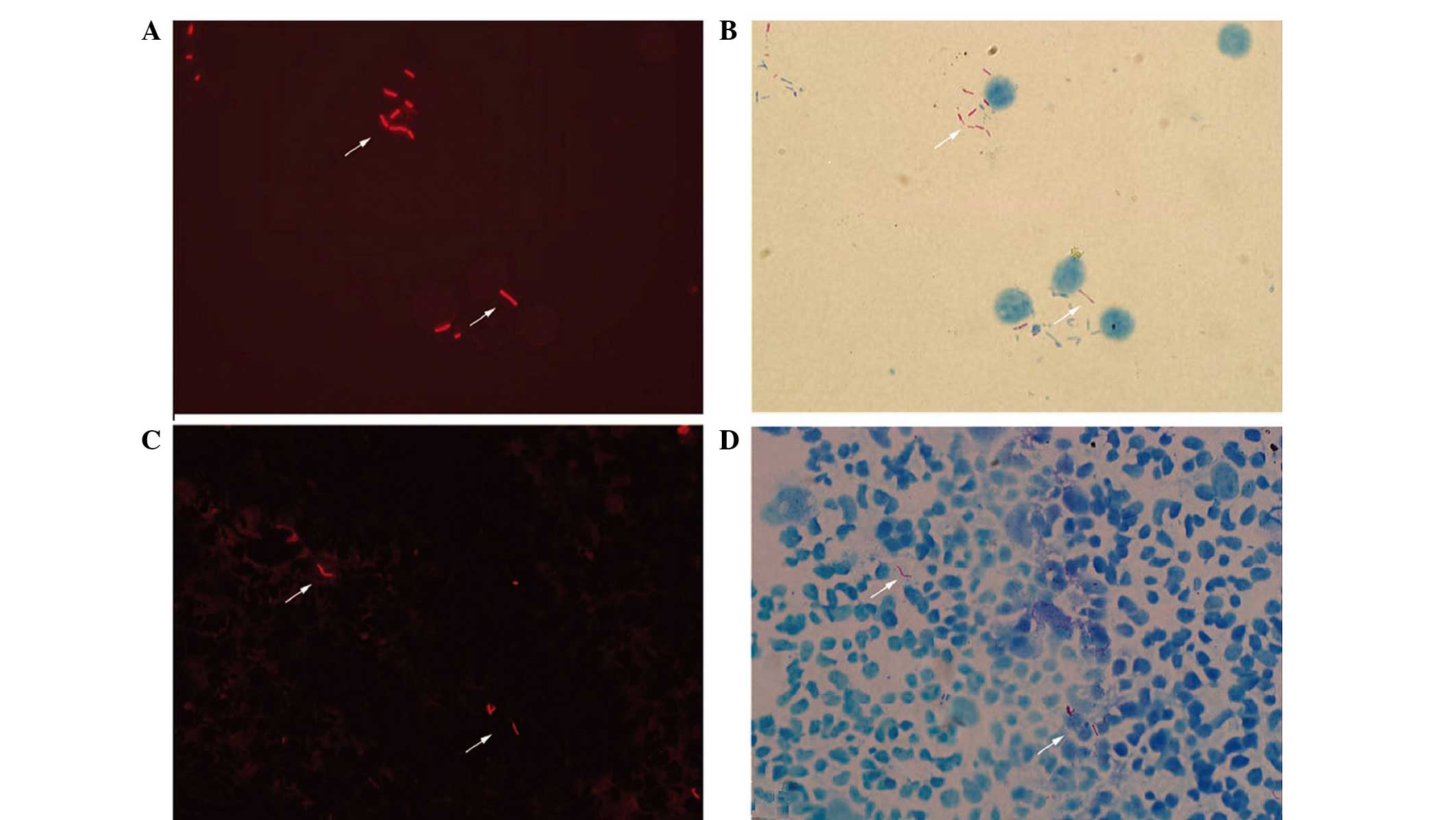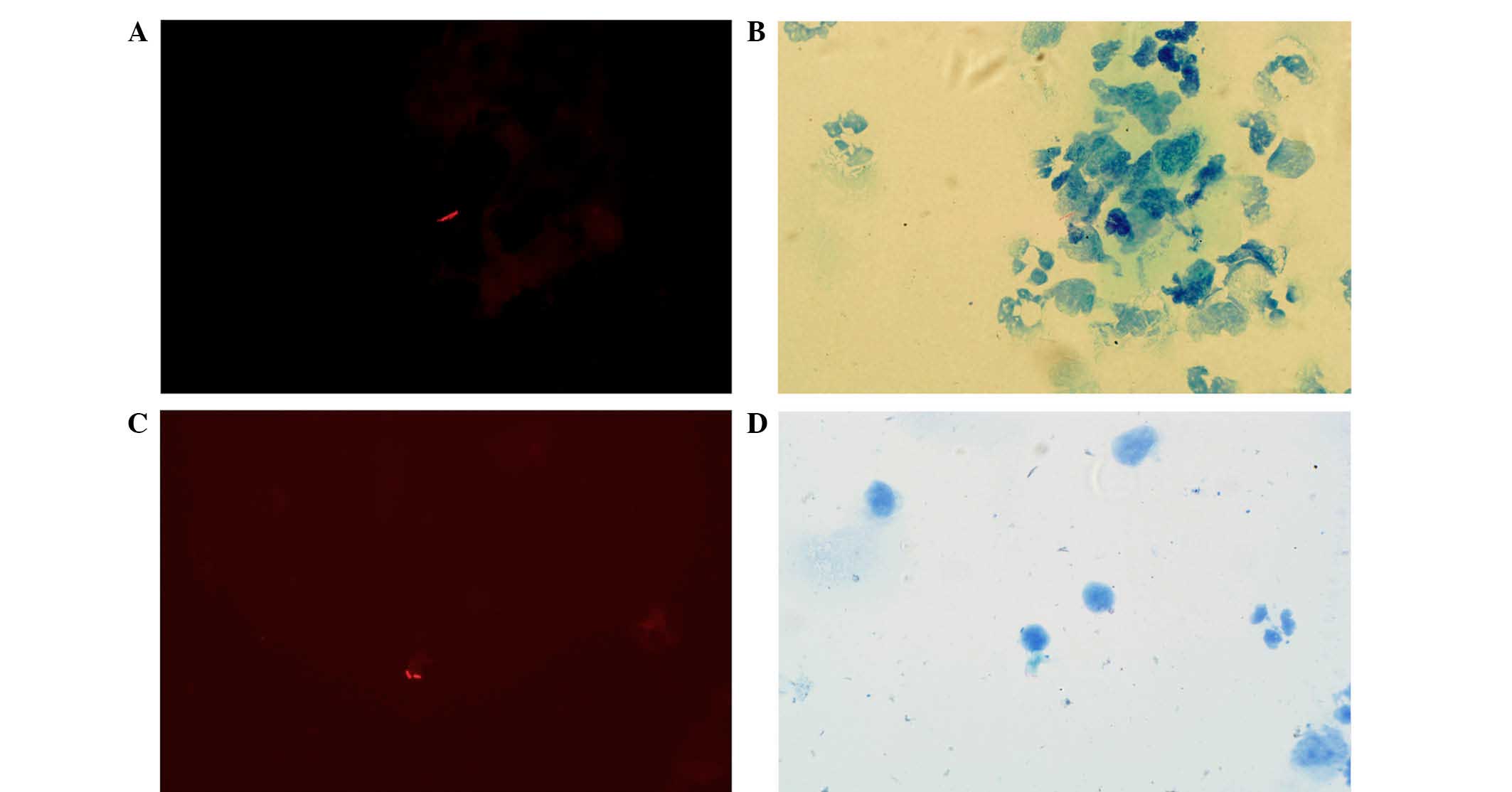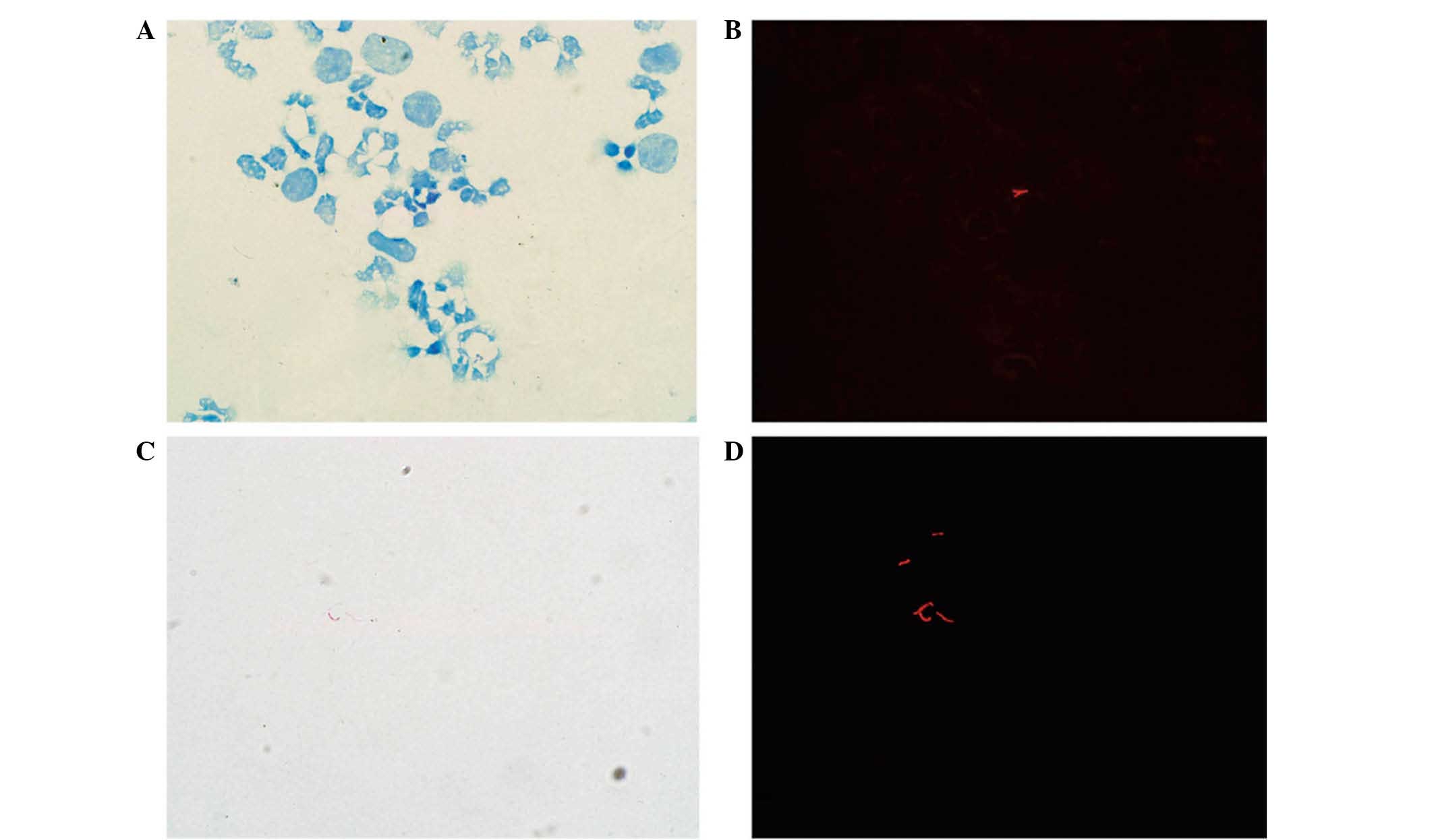|
1
|
Yu HY, Hu FS, Xiang DR and Sheng JF:
Clinical management of tuberculous meningitis: Experiences of 42
cases and literature review. Neurol Sci. 35:303–305. 2014.
View Article : Google Scholar : PubMed/NCBI
|
|
2
|
Elkington PT: Tuberculosis: Time for a new
perspective? J Infect. 66:299–302. 2013. View Article : Google Scholar : PubMed/NCBI
|
|
3
|
Zou Y, He J, Guo L, Bu H and Liu Y:
Prediction of cerebrospinal fluid parameters for tuberculous
meningitis. Diagn Cytopathol. 43:701–704. 2015. View Article : Google Scholar : PubMed/NCBI
|
|
4
|
Marais S, Thwaites G, Schoeman JF, Török
ME, Misra UK, Prasad K, Donald PR, Wilkinson RJ and Marais BJ:
Tuberculous meningitis: A uniform case definition for use in
clinical research. Lancet Infect Dis. 10:803–812. 2010. View Article : Google Scholar : PubMed/NCBI
|
|
5
|
Thwaites GE: Advances in the diagnosis and
treatment of tuberculous meningitis. Curr Opin Neurol. 26:295–300.
2013. View Article : Google Scholar : PubMed/NCBI
|
|
6
|
Chen P, Shi M, Feng GD, Liu JY, Wang BJ,
Shi XD, Ma L, Liu XD, Yang YN, Dai W, et al: A highly efficient
Ziehl-Neelsen stain: Identifying de novo intracellular
Mycobacterium tuberculosis and improving detection of extracellular
M. tuberculosis in cerebrospinal fluid. J Clin Microbiol.
50:1166–1170. 2012. View Article : Google Scholar : PubMed/NCBI
|
|
7
|
Feng GD, Shi M, Ma L, Chen P, Wang BJ,
Zhang M, Chang XL, Su XC, Yang YN, Fan XH, et al: Diagnostic
accuracy of intracellular Mycobacterium tuberculosis detection for
tuberculous meningitis. Am J Respir Crit Care Med. 189:475–481.
2014. View Article : Google Scholar : PubMed/NCBI
|
|
8
|
Ulrichs T, Lefmann M, Reich M, Morawietz
L, Roth A, Brinkmann V, Kosmiadi GA, Seiler P, Aichele P, Hahn H,
et al: Modified immunohistological staining allows detection of
Ziehl-Neelsen-negative Mycobacterium tuberculosis organisms and
their precise localization in human tissue. J Pathol. 205:633–640.
2005. View Article : Google Scholar : PubMed/NCBI
|
|
9
|
Yeager H Jr, Lacy J, Smith LR and
LeMaistre CA: Quantitative studies of mycobacterial populations in
sputum and saliva. Am Rev Respir Dis. 95:998–1004. 1967.PubMed/NCBI
|
|
10
|
Thwaites GE, Chau TT and Farrar JJ:
Improving the bacteriological diagnosis of tuberculous meningitis.
J Clin Microbiol. 42:378–379. 2004. View Article : Google Scholar : PubMed/NCBI
|
|
11
|
Radhakrishnan VV and Mathai A: Correlation
between the isolation of Mycobacterium tuberculosis and estimation
of mycobacterial antigen in cisternal, ventricular and lumbar
cerebrospinal fluids of patients with tuberculous meningitis.
Indian J Pathol Microbiol. 36:341–347. 1993.PubMed/NCBI
|
|
12
|
Marais BJ, Brittle W, Painczyk K,
Hesseling AC, Beyers N, Wasserman E, van Soolingen D and Warren RM:
Use of light-emitting diode fluorescence microscopy to detect
acid-fast bacilli in sputum. Clin Infect Dis. 47:203–207. 2008.
View Article : Google Scholar : PubMed/NCBI
|
|
13
|
Nhu NT, Heemskerk D, Thu do DA, Chau TT,
Mai NT, Nghia HD, Loc PP, Ha DT, Merson L, Thinh TT, et al:
Evaluation of GeneXpert MTB/RIF for diagnosis of tuberculous
meningitis. J Clin Microbiol. 52:226–233. 2014. View Article : Google Scholar : PubMed/NCBI
|
|
14
|
World Health Organization, . Global
Tuberculosis Control: WHO Report 2010. World Health Organization;
Geneva: 2010
|
|
15
|
Thwaites GE, van Toorn R and Schoeman J:
Tuberculous meningitis: More questions, still too few answers.
Lancet Neurlo. 12:999–1010. 2013. View Article : Google Scholar
|
|
16
|
Zakham F, Akrim M, El Mzibri M, Benjouad
A, El Aouad R and Ennaji MM: Rapid screening and diagnosis of
tuberculosis: A real challenge for the mycobacteriologist. Cell Mol
Biol (Noisy-le-grand). 58:(Suppl). S1632–S1640. 2012.
|
|
17
|
Shapiro HM and Hänscheid T: Fuchsin
fluorescence in Mycobacterium tuberculosis: The Ziehl-Neelsen stain
in a new light. J Microbiol Methods. 74:119–120. 2008. View Article : Google Scholar : PubMed/NCBI
|
|
18
|
Varea M, Clavel A, Doiz O, Castillo FJ,
Rubio MC and Gómez-Lus R: Fuchsin fluorescence and autofluorescence
in Cryptosporidium, Isospora and Cyclospora oocysts. Int J
Parasitol. 28:1881–1883. 1998. View Article : Google Scholar : PubMed/NCBI
|
|
19
|
Steingart KR, Henry M, Ng V, Hopewell PC,
Ramsay A, Cunningham J, Urbanczik R, Perkins M, Aziz MA and Pai M:
Fluorescence versus conventional sputum smear microscopy for
tuberculosis: A systematic review. Lancet Infect Dis. 6:570–581.
2006. View Article : Google Scholar : PubMed/NCBI
|
|
20
|
Kivihya-Ndugga LE, van Cleeff MR, Githui
WA, Nganga LW, Kibuga DK, Odhiambo JA and Klatser PR: A
comprehensive comparison of Ziehl-Neelsen and fluorescence
microscopy for the diagnosis of tuberculosis in a resource-poor
urban setting. Int J Tuberc Lung Dis. 7:1163–1171. 2003.PubMed/NCBI
|
|
21
|
Ulukanligil M, Aslan G and Tasçi S: A
comparative study on the different staining methods and number of
specimens for the detection of acid fast bacilli. Mem Inst Oswaldo
Cruz. 95:855–858. 2000. View Article : Google Scholar : PubMed/NCBI
|
|
22
|
Hänscheid T: The future looks bright:
Low-cost fluorescent microscopes for detection of Mycobacterium
tuberculosis and Coccidiae. Trans R Soc Trop Med Hyg. 102:520–521.
2008. View Article : Google Scholar : PubMed/NCBI
|
|
23
|
Lehman LG, Ngapmen Yamadji AL, Ngo Sack F
and Bilong Bilong CF: The CyScope® fluorescence
microscope, a reliable tool for tuberculosis diagnosis in
resource-limited settings. Am J Trop Med Hyg. 83:906–908. 2010.
View Article : Google Scholar : PubMed/NCBI
|
|
24
|
Habtamu M, van den Boogaard J, Ndaro A,
Buretta R, Irongo CF, Lega DA, Nyombi BM and Kibiki GS:
Light-emitting diode with various sputum smear preparation
techniques to diagnose tuberculosis. Int J Tuberc Lung Dis.
16:402–407. 2012. View Article : Google Scholar : PubMed/NCBI
|
|
25
|
Ba F and Rieder HL: A comparison of
fluorescence microscopy with the Ziehl-Neelsen technique in the
examination of sputum for acid-fast bacilli. Int J Tuberc Lung Dis.
3:1101–1105. 1999.PubMed/NCBI
|
|
26
|
Prasanthi K and Kumari AR: Efficacy of
fluorochrome stain in the diagnosis of pulmonary tuberculosis
co-infected with HIV. Indian J Med Microbiol. 23:179–181. 2005.
View Article : Google Scholar : PubMed/NCBI
|
|
27
|
Xia H, Song YY, Zhao B, Kam KM, O'Brien
RJ, Zhang ZY, Sohn H, Wang W and Zhao YL: Multicentre evaluation of
Ziehl-Neelsen and light-emitting diode fluorescence microscopy in
China. Int J Tuberc Lung Dis. 17:107–112. 2013. View Article : Google Scholar : PubMed/NCBI
|
|
28
|
Willett HP and Thacore H: Formation of
spheroplasts of Mycobacterium tuberculosis by lysozyme in
combination with certain enzymes of rabbit peritoneal monocytes.
Can J Microbiol. 13:481–487. 1967. View
Article : Google Scholar : PubMed/NCBI
|
|
29
|
Ye HP and Xu HP: Research about L-form of
Mycobacterium tuberculosis. Jiang Xi Zhong Yi Xue Yuan Xue Bao.
12:92–93. 2000.(In Chinese).
|
|
30
|
Sohn H, Sinthuwattanawibool C, Rienthong S
and Varma JK: Fluorescence microscopy is less expensive than
Ziehl-Neelsen microscopy in Thailand. Int J Tuberc Lung Dis.
13:266–268. 2009.PubMed/NCBI
|
|
31
|
Silva DR, Valentini DF Jr, Müller AM, de
Almeida CP and Pde T Dalcin: Pulmonary tuberculosis and lung
cancer: Simultaneous and sequential occurrence. J Bras Pneumol.
39:484–489. 2013. View Article : Google Scholar : PubMed/NCBI
|
|
32
|
Coussens LM and Werb Z: Inflammation and
cancer. Nature. 420:860–867. 2002. View Article : Google Scholar : PubMed/NCBI
|
|
33
|
Aibar-Arregui MA, de Escalante-Yangüela B,
Tejero-Juste C and Martín-Fortea MP: Mixed meningoencephalitis
caused by Mycobacterium tuberculosis and varicella zoster virus.
Rev Neurol. 48:91–93. 2009.(In Spanish). PubMed/NCBI
|
|
34
|
Cicenas S and Vencevicius V: Lung cancer
in patients with tuberculosis. World J Surg Oncol. 5:222007.
View Article : Google Scholar : PubMed/NCBI
|












